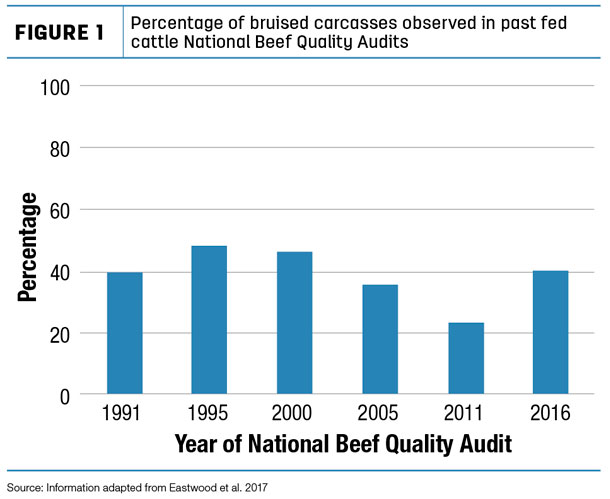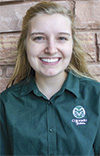The National Beef Quality Audit (NBQA), an endeavor partially funded by the Beef Checkoff, is a nationwide assessment conducted every five years to quantify various live animal and product traits to help identify areas for continuous improvement within the supply chain. Bruising is one outcome that has been measured over the past several NBQAs. Bruising is an important metric, as it can be viewed as both an animal welfare and economic concern. Bruise location, size, shape and age can provide information as to how cattle were handled prior to slaughter, and the information collected can be used to alter handling techniques or update facilities in order to reduce the prevalence of bruising.
The first NBQA was conducted in 1991 and has since been conducted approximately every five years in order to identify areas within the industry that still require attention and advancements. The most recent NBQA, completed in 2016, observed location, severity and number of bruises on carcasses and found that the percentage of fed cattle with bruises had increased 15.9 percent since 2011 to 38.9 percent (total carcasses observed: 24,366); there was also an increase in the number of carcasses that had multiple bruises. Figure 1 indicates percentage of bruised carcasses by NBQA year. The increase in bruised carcasses identifies an area that warrants further investigation.

The 2016 NBQA also reported fewer loin and rib bruises present, and more bruises located on the round, chuck and brisket. Additional studies have identified substantial bruising along the dorsal midline of cattle. Over the past several NBQAs, the size of beef carcasses has also increased, whereas the handling facilities and transport vehicles have not, perhaps one factor that plays a role in the observed increase in bruise prevalence and type. Occurrences of bruises can be associated with “traumatic events” (bumping, jamming, falling, etc.) during the production and transportation processes, allowing solutions to be created in order to address the concern for animal welfare among producers and consumers. If we can come up with solutions to minimize the potential for bruising as we handle cattle through our facilities, we will likely see a decrease in bruised carcasses at the packing plant.
Estimates suggest that bruising in cattle costs the industry about $35 million per year. Any part of a carcass that is bruised must be discarded because of the potential for bacterial proliferation, causing a decrease in carcass value and an overall economic loss for the producer. In addition to the concern for welfare, it is extremely important to relate knowledge gained from bruises to events that could have caused the injury. Working backwards through the process and identifying specific handling techniques that can be improved would benefit not only animal welfare, but producer profit as well.
Colorado State University’s livestock behavior and welfare research group within the department of animal science is currently conducting research with the intent of identifying events that occur during preslaughter cattle handling that can contribute to carcass bruising. Helen Kline, a current Ph.D. candidate, followed individually identified, as well as randomly selected, finished steers, cows and bulls from unloading at the plant through the slaughter process in order to investigate events that caused bruising. Out of all cattle observed, 26.6 percent were bruised.
A unique component of this study was weighing the actual bruised meat that had to be trimmed off the carcass – final results will be able to provide a monetary value for specific bruises by location. Additionally, several live animal parameters such as animal type (cow versus fed steer versus bull), mobility score and body condition were measured in this study and will be explored as impacting factors. Taking another step backwards into the process, as a graduate student, I will observe loading at the feedlot and handling at several locations at the plant (e.g., unloading, antemortem inspection, handling in the crowd pen) to determine if there is a relationship between carcass bruising and cattle handling to further elucidate potential critical control points for bruising.
By quantifying carcass characteristics in order to determine causes of defects, the welfare of cattle and profit for the producer will steadily improve. Meat quality can be a measure of antemortem animal handling; thus, refined handling techniques established by information gleaned via national assessments and research initiatives will serve as a way of advancing the industry. ![]()
References omitted but are available upon request. Click here to email an editor.

-
Kristin Wade
- Interim Colorado BQA State Coordinator
- Graduate Student
- Colorado State University







